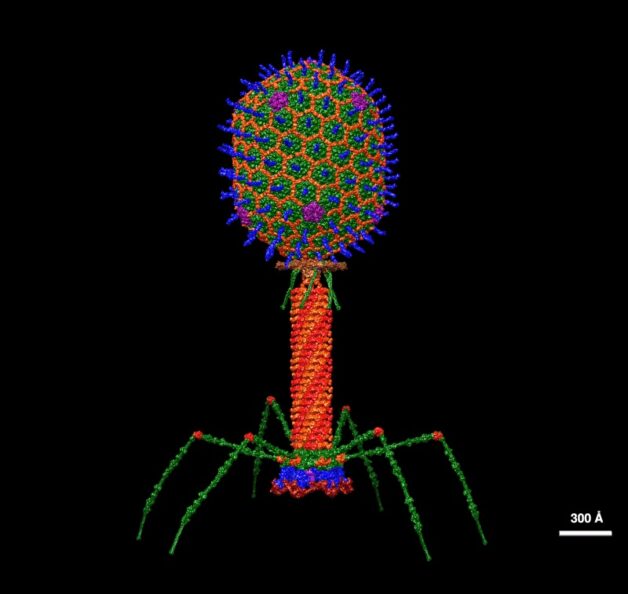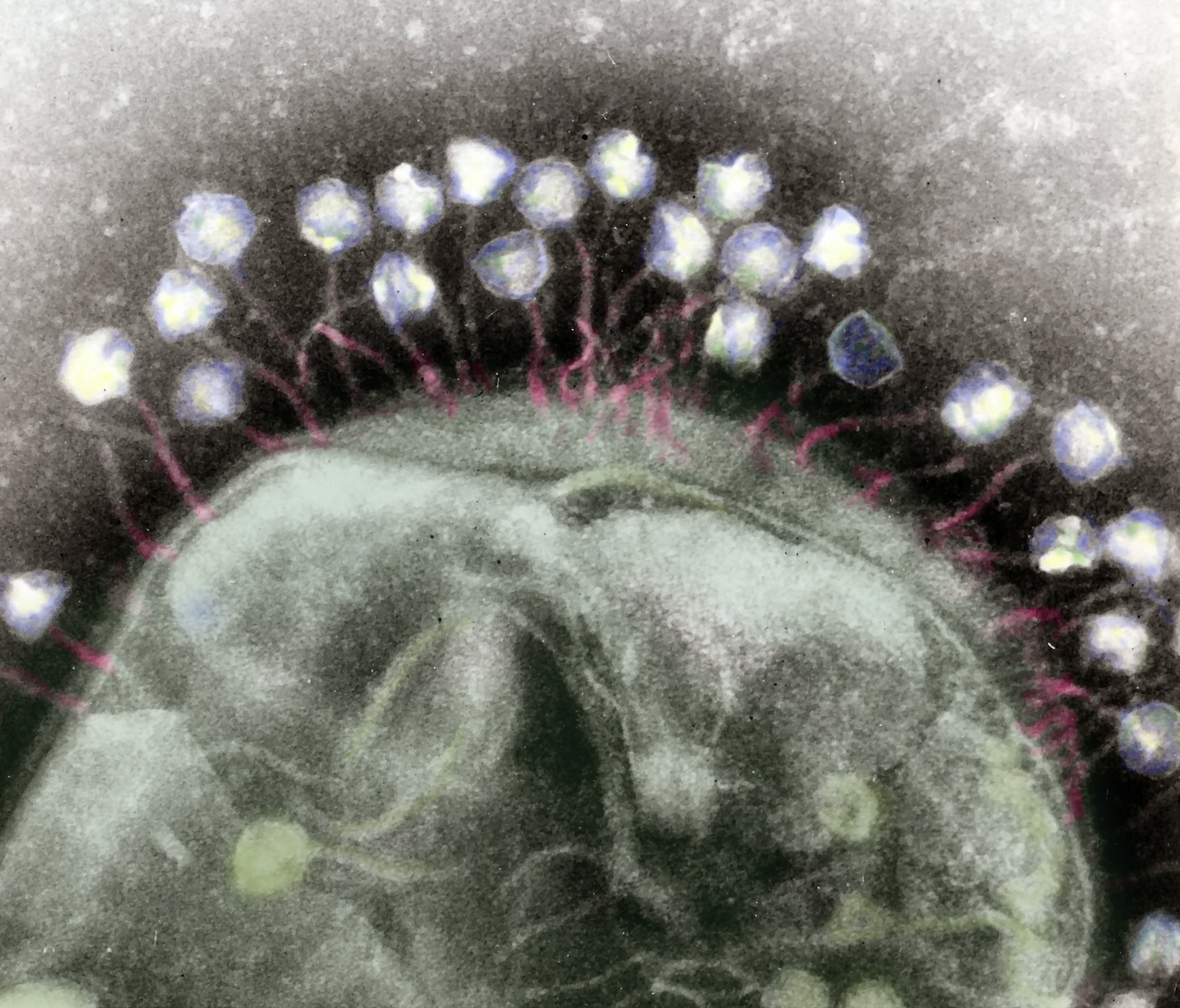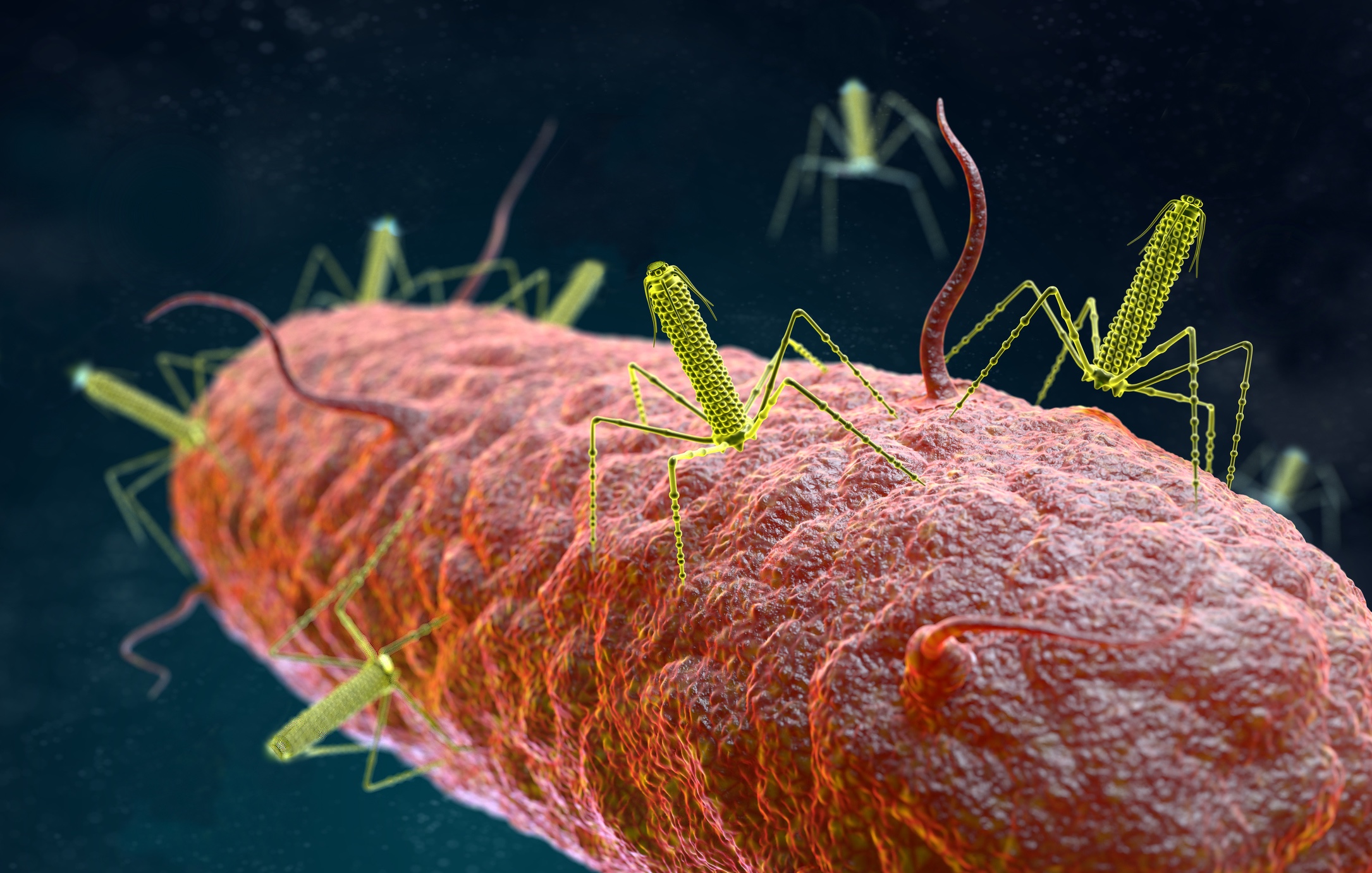CRISPR, the Nobel Prize-winning gene editing technology, is poised to have a profound impact on the fields of microbiology and medicine yet again.
A team led by CRISPR pioneer Jennifer Doudna and her longtime collaborator Jill Banfield has developed a clever tool to edit the genomes of bacteria-infecting viruses called bacteriophages using a rare form of CRISPR. The ability to easily engineer custom-designed phages – which has long eluded the research community – could help researchers control microbiomes without antibiotics or harsh chemicals, and treat dangerous drug-resistant infections. A paper describing the work was recently published in Nature Microbiology.
“Bacteriophages are some of the most abundant and diverse biological entities on Earth. Unlike prior approaches, this editing strategy works against the tremendous genetic diversity of bacteriophages,” said first author Benjamin Adler, a postdoctoral fellow in Doudna’s lab. “There are so many exciting directions here – discovery is literally at our fingertips!”

An atomic structural model of a T4 phage, the type edited in this research. (Credit: Dr. Victor Padilla-Sanchez/Wikimedia Commons)
Bacteriophages, also simply called phages, insert their genetic material into bacterial cells using a syringe-like apparatus, then hijack the protein-building machinery of their hosts in order to reproduce themselves – usually killing the bacteria in the process. (They’re harmless to other organisms, including us humans, even though electron microscopy images have revealed that they look like sinister alien spaceships.)
CRISPR-Cas is a type of immune defense mechanism that many bacteria and archaea use against phages. A CRISPR-Cas system consists of short snippets of RNA that are complementary to sequences in phage genes, allowing the microbe to recognize when invasive genetic material has been inserted, and scissor-like enzymes that neutralize the phage genes by cutting them into harmless pieces, after being guided into place by the RNA.
Over millennia, the perpetual evolutionary battle between phage offense and bacterial defense forced phages to specialize. There are a lot of microbes, so there are also a lot of phages, each with unique adaptations. This astounding diversity has made phage editing difficult, including making them resistant to many forms of CRISPR, which is why the most commonly used system – CRISPR-Cas9 – doesn’t work for this application.
“Phages have many ways to evade defenses, ranging from anti-CRISPRs to just being good at repairing their own DNA,” said Adler. “So, in a sense, the adaptations encoded in phage genomes that make them so good at manipulating microbes are the exact same reason why it has been so difficult to develop a general-purpose tool for editing their genomes.”
Project leaders Doudna and Banfield have developed numerous CRISPR-based tools together since they first collaborated on an early investigation of CRISPR in 2008. That work – performed at Lawrence Berkeley National Laboratory (Berkeley Lab) – was cited by the Nobel Prize committee when Doudna and her other collaborator, Emmanuelle Charpentier, received the prize in 2020. Doudna and Banfield’s team of Berkeley Lab and UC Berkeley researchers were studying the properties of a rare form of CRISPR called CRISPR-Cas13 (derived from a bacterium commonly found in the human mouth) when they discovered that this version of the defense system works against a huge range of phages.
The phage-fighting potency of CRISPR-Cas13 was unexpected given how few microbes use it, explained Adler. The scientists were doubly surprised because the phages it defeated in testing all infect using double-stranded DNA, but the CRISPR-Cas13 system only targets and chops single-stranded viral RNA. Like other types of viruses, some phages have DNA-based genomes and some have RNA-based genomes. However, all known viruses use RNA to express their genes. The CRISPR-Cas13 system effectively neutralized nine different DNA phages that all infect strains of E. coli, yet have almost no similarity across their genomes.
According to co-author and phage expert Vivek Mutalik, a staff scientist in Berkeley Lab’s Biosciences Area, these findings indicate that the CRISPR system can defend against diverse DNA-based phages by targeting their RNA after it has been converted from DNA by the bacteria’s own enzymes prior to protein translation.
Next, the team demonstrated that the system can be used to edit phage genomes rather than just chop them up defensively.
First, they made segments of DNA composed of the phage sequence they wanted to create flanked by native phage sequences, and put them into the phage’s target bacteria. When the phages infected the DNA-laden microbes, a small percentage of the phages reproducing inside the microbes took up the altered DNA and incorporated it into their genomes in place of the original sequence. This step is a longstanding DNA editing technique called homologous recombination. The decades-old problem in phage research is that although this step, the actual phage genome editing, works just fine, isolating and replicating the phages with the edited sequence from the larger pool of normal phages is very tricky.
This is where the CRISPR-Cas13 comes in. In step two, the scientists engineered another strain of host microbe to contain a CRISPR-Cas13 system that senses and defends against the normal phage genome sequence. When the phages made in step one were exposed to the second-round hosts, the phages with the original sequence were defeated by the CRISPR defense system, but the small number of edited phages were able to evade it. They survived and replicated themselves.
Experiments with three unrelated E. coli phages showed a staggering success rate: more than 99% of the phages produced in the two-step processes contained the edits, which ranged from enormous multi-gene deletions all the way down to precise replacements of a single amino acid.
“In my opinion, this work on phage engineering is one of the top milestones in phage biology,” said Mutalik. “As phages impact microbial ecology, evolution, population dynamics, and virulence, seamless engineering of bacteria and their phages has profound implications for foundational science, but also has the potential to make a real difference in all aspects of the bioeconomy. In addition to human health, this phage engineering capability will impact everything from biomanufacturing and agriculture to food production.”
Buoyed by their initial results, the scientists are currently working to expand the CRISPR system to use it on more types of phages, starting with ones that impact microbial soil communities. They are also using it as a tool to explore the genetic mysteries within phage genomes. Who knows what other amazing tools and technologies can be inspired by the spoils of microscopic war between bacteria and virus?
This research was funded by the Department of Energy Microbial Community Analysis & Functional Evaluation in Soils (m-CAFES) Scientific Focus Area. Jill Banfield is a professor of Earth and Planetary Science and Environmental Science, Policy, & Management at UC Berkeley as well as a faculty scientist in Berkeley Lab’s Earth and Environmental Sciences Area and an affiliate in the Biosciences Area. Jennifer Doudna is a professor in the Molecular and Cell Biology and Chemistry departments at UC Berkeley and a faculty scientist in Berkeley Lab’s Biosciences Area.
CRISPRing the Microbiome
In related research by collaborators at North Carolina State University, an engineered phage (made using a different CRISPR) was used to insert a CRISPR-Cas9 system inside a strain of E coli. The proof-of-concept experiment demonstrated that an engineered virus could indeed thwart bacterial defenses and make selective changes to the target’s genome – and do so in an artificial environment with other, non-targeted bacteria nearby. In this case, the environment was designed to replicate the soil that closely interacts with plant roots, as the scientists hope to use CRISPR to improve methods for sustainable agriculture by controlling the composition of the soil microbiome. “Ultimately this study represents the next chapter of CRISPR delivery – using viruses to deliver CRISPR machinery in a complex environment,” said lead researcher Rodolphe Barrangou, a professor of Food, Bioprocessing and Nutrition Sciences.
# # #
Founded in 1931 on the belief that the biggest scientific challenges are best addressed by teams, Lawrence Berkeley National Laboratory and its scientists have been recognized with 16 Nobel Prizes. Today, Berkeley Lab researchers develop sustainable energy and environmental solutions, create useful new materials, advance the frontiers of computing, and probe the mysteries of life, matter, and the universe. Scientists from around the world rely on the Lab’s facilities for their own discovery science. Berkeley Lab is a multiprogram national laboratory, managed by the University of California for the U.S. Department of Energy’s Office of Science.
DOE’s Office of Science is the single largest supporter of basic research in the physical sciences in the United States, and is working to address some of the most pressing challenges of our time. For more information, please visit energy.gov/science.



